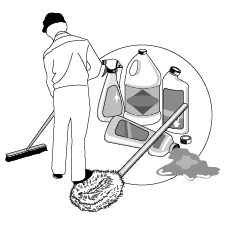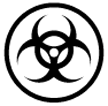Sanitation and Infection Control for Cleaning Staff
On this page
- What situations does this document cover?
- What are some general tips to keep in mind about sanitation?
- What are some tips about cleaning blood and body fluids?
- What are some tips when cleaning and disinfecting for virus control in a workplace, such as the coronavirus?
- What are some basic hand washing guidelines?
- What should you know about biohazardous waste?
- Where can I get more information about infection control?
What situations does this document cover?
Back to topThis OSH Answers document covers cleaning disinfection and other sanitation activities in retail, offices, schools and similar workplaces, but does not cover work environments with specialized sanitation needs, such as health care, food processing, etc.
If your workplace has a specific infection or sanitation control procedure, please ask your supervisor or infection control officer for more information.
What are some general tips to keep in mind about sanitation?
Back to topIt is important that all facilities are free from garbage, debris, filth, and potentially infectious materials.
DO
- Follow procedures and safe work practices recommended by your employer.
- Check product labels and safety data sheets (SDSs) (if available) to know the potential hazards and safe work practices for all cleaning and disinfecting products you use.
- Participate in Workplace Hazardous Materials Information System (WHMIS) training when working with hazardous products.
- Wear personal protective equipment and clothing as appropriate for the products you are working with or cleaning.
- Use cleaning products appropriate to your workplace and according to the supplier's recommendation to ensure effective cleaning results.
- Always clean and wash surfaces/areas thoroughly before disinfecting them.
- Use disinfecting products or diluted bleaches (i.e.,. sodium hypochlorite) to disinfect areas as required.
- After using cleaning products, wash hands thoroughly with water and soap, after removing gloves. Also, remember to always wash your hands before you eat, drink or smoke; or after you have used the toilet.
- Report to your supervisor all spills, incidents, etc.
DO NOT
- Do not eat, drink, or smoke while using bleaches, cleaning agents, disinfecting agents, or other chemical products.
- Do not leave open containers of bleaches, chemical products, disinfecting agents, and solvents in the washrooms or other areas used by other staff, students, visitors or other members of the public.
- Do not mix cleaners and disinfectants unless the labels say it is safe to do so. Mixing products (such as chlorine bleach and ammonia cleaners) can react to create poisonous substances which can cause serious injury.

What are some tips about cleaning blood and body fluids?
Back to topUse these suggestions if you come in contact with blood or other body fluids. It is important to follow these tips as blood and body fluids may be infectious.
When cleaning and decontaminating blood and body fluid contaminated areas:
DO
- Wear gloves and use disposable towels or other means of cleaning (e.g., brooms or shovels) that will stop direct contact between you and the blood or body fluids.
- Decontaminate the area with an approved disinfecting agent or a 1:100 solution of household bleach (that is, dilute 1 part bleach with 99 parts water).
- Once the cleanup is finished, all tools or equipment used should be washed and disinfected.
- Throw out all soiled cleaning materials in a leak-proof plastic bag. Throw out this bag according to local or public health regulations for the disposal of infectious waste.
- Wash hands thoroughly with warm water and soap, after removing gloves.
- Change gloves after each task or exposure.
- Dispose of your used gloves as you would for contaminated materials.
What are some tips when cleaning and disinfecting for virus control in a workplace, such as the coronavirus?
Back to topA touch point is any surface that can be touched by bare hands by multiple people, multiple times.
- Make sure that any person required to clean and disinfect has received the appropriate training plus any required personal protective equipment.
- Create a checklist of all surfaces that must be cleaned, especially touch points (e.g., door knobs, handles, kettles, coffee makers, water faucets, or other shared items (e.g., touch screens, photocopiers, telephones, etc.).
- Determine the frequency of cleaning and disinfection based on your workplace's needs. Clean at least once per day but more frequent cleaning (every 2 to 3 hours) may be necessary. If the workplace is operating in shifts of workers, clean between or at least once during each shift.
- Clean visibly dirty or soiled surfaces with soap and water or a cleaning product before disinfecting.
- Use a disinfectant or bleach solution to destroy or inactivate the virus.
- Use a disinfectant with a drug identification number (DIN). This number means that it has been approved for use in Canada
- If household or commercial disinfectant cleaning products are not available, hard surfaces can be disinfected using a mixture of 5 mL of bleach (5% sodium hypochlorite) and 250 mL of water. Test surfaces before using a bleach solution. Bleach can be corrosive.
- Bleach solutions should be refreshed daily (they lose disinfectant properties within 24 hours)
- If liquids can be withstood, disinfect high-touch electronic devices (keyboards, tablets, smartboards) with disinfectant or alcohol wipes.
- Use a dedicated cloth for cleaning. Change the cloth daily or when it becomes visibly soiled.
- Follow the product’s label for the required dwell time (i.e., the time the product should “sit” on the surface) to allow for effective disinfection. In most cases, apply enough disinfectant to leave a visible film on the surface. Allow the surface to air dry.
- Apply the disinfectant to a clean cloth. Saturate the cloth before treating touch points. Reapply as needed.
- Reapply disinfectant to the cloth between surfaces.
- Provide plastic lined waste containers and use disposable gloves to empty the garbage.
- Record when cleaning and disinfection has occurred.
What are some basic hand washing guidelines?
Back to top- Wash hands regularly especially after each exposure.
- Wet, soap and lather for at least 20 seconds.
- Lather all fingers, thumbs, between fingers, wrists, backs of hands and lower arms.
- Wash and scrub under the nails.
- Rinse thoroughly and dry using a paper towel or an air dryer.
- If available, turn off the taps/faucets with a paper towel (so you do not re-contaminate your hands).
Use an alcohol-based hand sanitizer (at least 60% alcohol) when soap and water are not available.
Please see Hand Washing for more information.
What should you know about biohazardous waste?
Back to topOccasionally, you may encounter discarded hypodermic needles, syringes, condoms, objects, materials or fluids that may be contaminated with blood or body fluids. You must use special precautions when handling such materials/objects. Often these biological wastes are contaminated with "germs" or other pathogens which carry diseases. For example hepatitis B, hepatitis C and HIV/AIDS are all spread through contact with body fluids.
DO
- Ask your supervisor for training to be able to:
- understand potential hazards
- be familiar with regulations
- Consider all biological wastes as infectious.
- Handle all contaminated wastes carefully to prevent body contact and injury. For example, carry objects or waste containers and bags away from your body to reduce the chance of coming in contact with a sharp object.
- Wear puncture-resistant gloves and safety boots appropriate for the situation.
- Try not to touch a sharp object such as a needle. Use a dustpan or shovel to move it.
- Dispose of sharp objects and infectious waste in a puncture-resistance container such as a bucket with a secure lid and lined with leak-proof, puncture-resistant plastic.
- Put a biological hazard symbol on the container if it does not have one already. Puncture resistant, preprinted containers for sharps are commercially available.

- Wear puncture-resistant or leather gloves and empty waste baskets (or other containers) by holding container on the outside.
- Handle waste containers by holding onto the outside when transferring the waste into a larger container or tie the garbage liner at the top and pull up the waste from the container by the knot. DO NOT empty or carry the container by putting your fingers on the inside.
- Dispose of infectious or biohazard waste according to local laws and regulations.
- Call your local public health department for further assistance.
DO NOT
- Do not load waste containers beyond their capacities.
- Do not compact infectious waste. This process may spread the contamination.
- Do not mix infectious waste with regular garbage or trash.
- Do not reach your hand into any waste container, receptacle, or pile of waste which may contain hazardous waste.
Where can I get more information about infection control?
Back to topMore information in other OSH Answer documents includes:
- Routine Practices for workplaces where workers are exposed to viruses, blood and certain other body fluids.
- Hand Washing practices to reduce the risk of common infections.
- Fact sheet last revised: 2021-02-17

